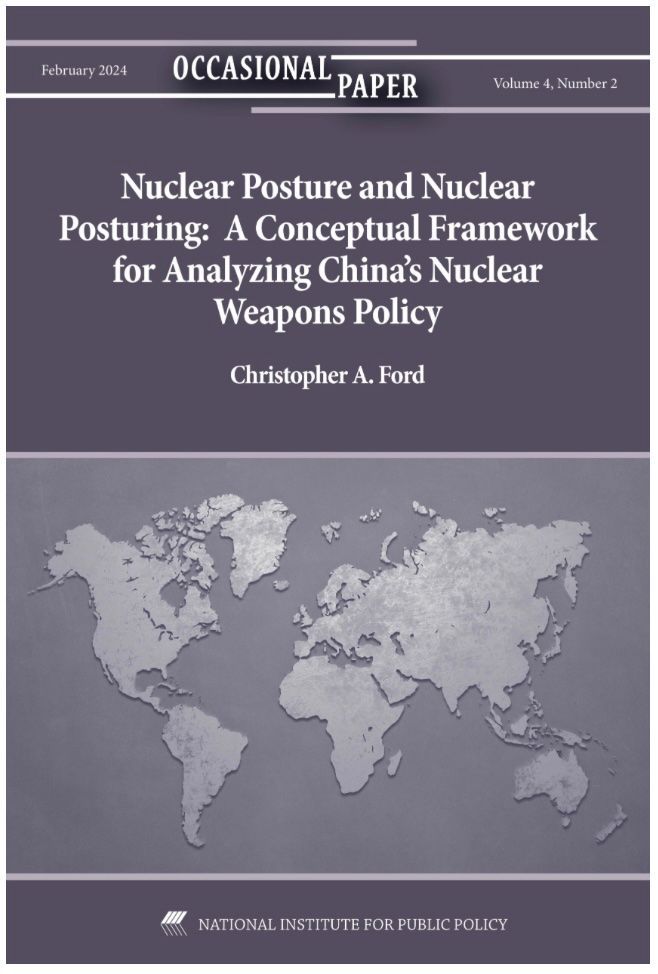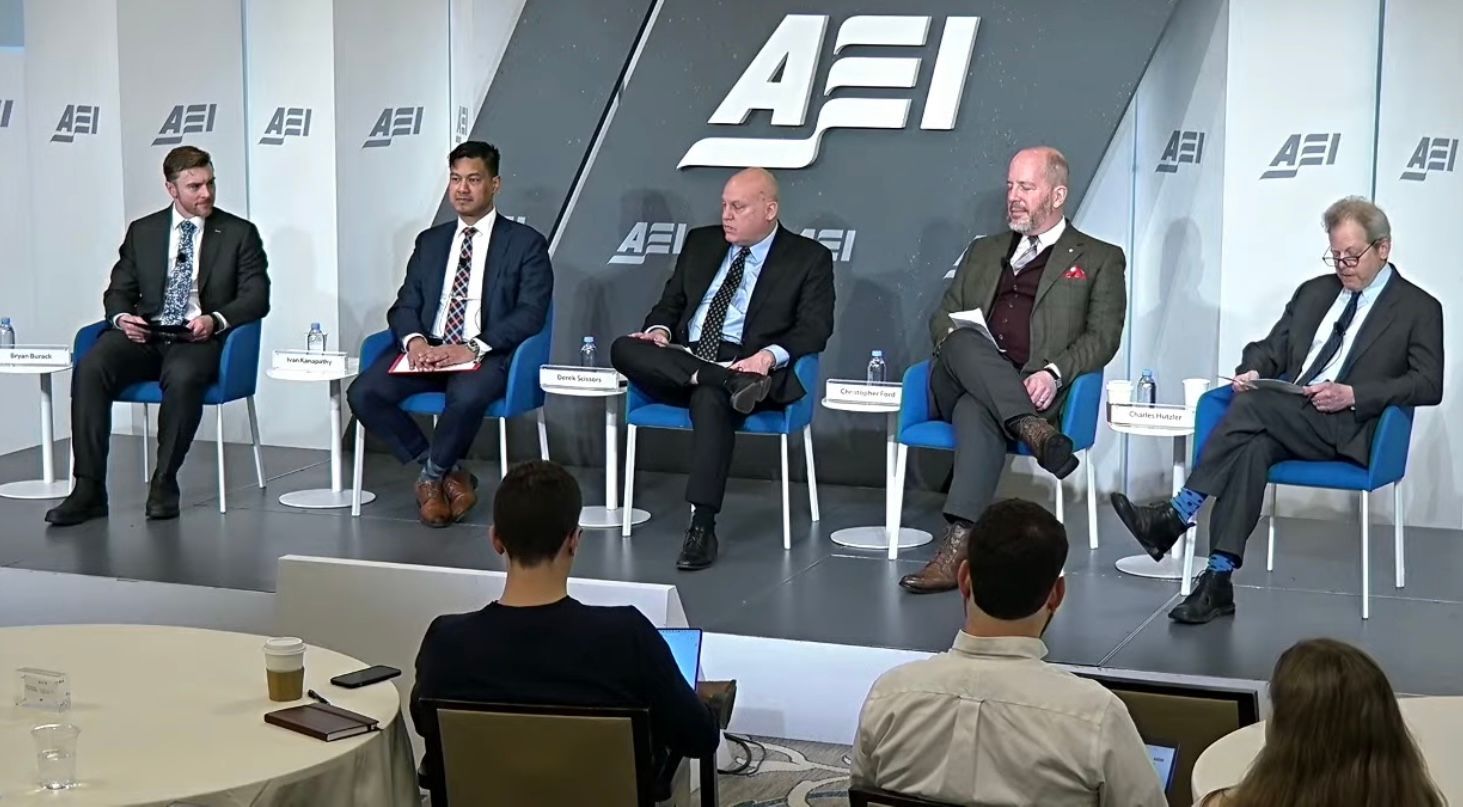The Hon. Christopher A. Ford
New Paradigms Forum -- International Security Policy Since 2009
Devil in the Details: Nuclear Command and Control in a Nuclear-Armed Middle East
Note:
These remarks were given at a panel at Hudson Institute on February 24, 2010, on “ A Nuclear Middle East: Strategic Balance or Annihilation? ” (You can also download a PDF using the button below.)
In mulling over what the emergence of a nuclear-armed Middle East might actually mean, I thought it would be interesting to explore the question from the perspective of nuclear weapons command and control.
In U.S. military jargon, it is common to speak in terms of C 3 I – pronounced, horribly, “see-cubed-eye” – an acronym that stands for “command, control, communications, and intelligence.” Conceptually, if by no means necessarily in organizational terms, all four elements are part of a “package.” Command refers to one’s information-receipt and decision-making functions. Control means, broadly, the transmittal to relevant operational units of the commander’s intentions. Intelligence , in turn, is the systematic gathering of information about what others’ relevant operational units are doing, and about their intentions, plans, strategies, and so forth, while Communications refers to the linkages that make these things possible. The acronym thus reflects a systems analysis approach to understanding command. Real-life systems do not necessarily need to be compartmented along such lines, but these core functions will presumably be fulfilled, to some extent, in every system. But details matter.
The U.S. experience with nuclear command-and-control involved decades of preparations for the possibility World War Three with Soviet bloc. Contingency planning contemplated possible nuclear exchanges in multiple theaters, ranging from battlefield weapons to strategic attacks on population centers, and it involved vexing issues of communication and control in the context of second-strike management, battle damage assessment, follow-on targeting, and leadership survival and communications in the face of blast, radiation, and electromagnetic pulse effects on an appalling scale.
The system aimed to maximize decision-making flexibility in the mere minutes that might be available to the president, but it also provided elaborate pre-planned options, most famously the terrifyingly destructive Single Integrated Operational Plan – which Lyndon Johnson once said “frightened the devil out of me.” Through the prism of U.S. strategic nuclear priorities and assumptions, moreover, nuclear command-and-control issues also included safety and security of nuclear weapons and their associated delivery systems against accident or Soviet espionage or sabotage even in peacetime, as well as issues of crisis management associated with the transition between peace and war – a shift which, it was felt, might be very quick.
All of these preparations were part of an incredibly elaborate and expensive effort over many years by highly skilled professionals using state-of-the-art analytical tools, yet at one level it was all just guesswork. As Herman Kahn, the founder of Hudson Institute, was fond of noting, when it comes to issues of nuclear warmaking we are all amateurs. No one, thankfully, has real experience of it. Remembering that the intricate U.S. command-and-control system was based in part upon so much guesswork can be useful.
The Contingency of C 3 I
The form that the U.S. approach took was driven by an explicit or implicit strategic choice to focus upon a particular vision of nuclear warfighting, and it was thus grounded in particular assumptions about nuclear weapons, their role in global security, the nature of the Soviet adversary, and the circumstances that the United States and its allies might face in the future. This process began when the United States was not long out of the crucible of total, global war against Germany and Japan, and as it began to feel caught in a strategic arms race and zero-sum contest over the politico-economic fate of humanity. The United States, in other words, developed its command and control system based upon its understanding of its strategic environment.
This observation sounds almost trivial if expressed in that form, for of course it is true that countries build security institutions based upon their assumptions about the world they confront. Yet such a seeming banality hides an important point. Nuclear command-and-control does not exist as a sort of Platonic archetype toward which nuclear-armed countries all invariably strive to the best of their ability. The focus and details of such systems are to some a question of implicit or explicit choice, and their parameters will depend not simply upon resources and capabilities but upon the purposes the fulfillment of which a country’s leaders feel it most important to ensure.
It seems highly unlikely that anyone in the region will focus – at least not for a long time – upon the challenges of large-scale, sustained nuclear warfighting against a similarly-armed opponent in anything remotely like the way to which U.S. planners became accustomed during the Cold War. This is not just a question of resources, but also about choices and priorities, and assumptions regarding potential adversaries, one’s own objectives and goals, nuclear weaponry, or even the nature of war itself. Other countries, especially modern newcomers to the nuclear weapons business who never played any role in the nuclear aspects of the Cold War standoff, may see issues of nuclear peace and war through very different lenses – and may thus shape their approaches in what are, to our eyes, somewhat idiosyncratic ways.
The efficacy of nuclear deterrence as understood in Washington during the Cold War did not depend upon the assumption of eventual weapons use, but whether for prewar “credibility” purposes or for actual wartime battle management, command-and-control planning necessarily presumed it as a real possibility. Whether or not one accepted the arguments of some nuclear strategists – among them our own Herman Kahn – about the importance of tailoring nuclear moves with an eye to intra-war bargaining, escalation, de-escalation, and termination dynamics, U.S. presidents consistently asked for a range of options and their strategic planners claimed to provide this. It remains open to debate whether any president would have felt that he had all that much flexibility in practice, but control remained an ambition of the system even in the most horrifying of circumstances.
The U.S. architecture thus evolved out of an awkward dance between the value of centrally-calibrated use-control and the value of improvisational flexibility and survivability. Redundant communications networks, instantly-deployable aerial command-and-control assets, hardened command posts, survivable second-strike forces, and bomber squadrons expected to be capable of ad hoc dynamic re-tasking in mid-conflict were all built around the challenge of managing this tension.
Different grounding assumptions about what “warfighting” means, however – or whether it is a serious priority at all – would presumably produce very different institutional and programmatic manifestations. What would it mean if a country didn’t particularly focus upon nuclear “warfighting” in the Cold War sense? Would weapons-control systems built to some degree around other priorities be more stabilizing, in the sense that they would seem less to presume nuclear use? Or would they be a new source of instability , insofar as such systems could prove particularly brittle in a crisis they were never really designed to handle, thereby worsening early-use incentives that could have been to some extent mitigated by more robust command-and-control capabilities? And what if multiple countries, each building upon a different set of grounding assumptions, ended up playing complicated multi-player deterrence games with each other?
Adding to the complexity of the analytical task, we should also remember that the U.S. approach to command and control did not spring forth with an exultant shout from the head of Zeus, full-grown and fully armed, as Pindar tells us the Greek goddess Athena did. Quite the contrary. It developed over a long period of time in response to assumed needs, available resources and technologies, the actual or presumed behavior and intentions of our strategic adversary, and on the basis of trial and error. Its developers had the advantage of a long “learning curve” of studying and interacting with a single strategic adversary – and it with them – year after year, for decades. (On the U.S. side, moreover, the process of strategic “learning” also involved a vibrant public contestedness, with many nuclear weapons and deterrence-theory issues discussed quite freely and openly in a context of political pluralism that was, to some extent, an “open book” to the adversary.) For a variety of reasons, this experience is likely to generalize rather poorly, especially to a multi-player nuclear-armed Middle East.
Even if one grants that relative U.S.-Soviet strategic stability did not involve a lot of luck, therefore, we would seem to have little defensible basis upon which to extrapolate from the Cold War experience to any sort of conclusions about nuclear control behavior and the stability of deterrence elsewhere. This is particularly true if one assumes that a nuclear-armed Middle East is not likely long to remain a bipolar competition – e.g., between Israel and Iran. If indeed Iranian capabilities would prompt weapons development by neighbors worried about Tehran’s aspirations to regional hegemony, a multipolar balance might develop – and we do not really know, or yet even have good conceptual tools with which to begin to assess, whether and to what extent multi-party nuclear deterrence differs from the two-party games to which the Cold War accustomed us.
Mirror-Images and Strategic Culture
Mirror-imaging can be a dangerous analytical trap. Some years ago, the Rumsfeld Commission taught us important lessons about the need to avoid assuming that others will necessarily do things the way we did in developing ballistic missiles. We also know enough, now, not just to look for arms control cheats by searching for Soviet-style industrial-scale chemical and biological weapons work; the way such things were approached in the past is not necessarily the way they will be handled in the future. The Iraq Survey Group, moreover, has taught an important lesson about how the incentives facing weapons of mass destruction (WMD) program managers in other countries may look – and produce choices – entirely unlike our own past experiences. (Who would have predicted ahead of time, for instance, that Saddam Hussein himself might have been to some extent misled about the efficacy, or even the existence, of aspects of Iraq’s WMD?)
One should, of course, not over -learn the lessons against mirror-imaging, for it would be as wrong to assume that others will never follow what are for us familiar paths as it would be to assume that they will. (Perhaps the only tenable a priori assumption in this regard is that one should resist a priori assumptions: these issues are largely empirical, rather than theoretical, matters.) Nevertheless, if we see questions of nuclear command and control solely through the lens of our own experiences, we may miss other purposes that such institutions and procedures may be designed to serve, and we may thus misunderstand how such countries would behave if it really came to a nuclear crisis. If modern-day Iran – riven by conflict between an increasingly democracy-minded political opposition and an insecure and radicalized theocratic clique – builds a nuclear command-and-control system, what would it look like? And what behavior would such a system tend to encourage or preclude?
If I had to guess, I would think that peacetime control of nuclear weapons and related information, the political and religious reliability of those involved in the operational control of such weapons, other internal security issues, and considerations of the system’s resistance to conventional (rather than nuclear) counterforce attack might well be given far higher priority in Iran than Cold War style warfighting. From the perspective of the clerical-Pasdaran junta, in fact, it is not entirely clear how important actual nuclear warfighting would be anyway. Indeed, given the eschatological proclivities of the faction with which President Ahmadinejad is apparently affiliated – especially within a religious context in which people seem remarkably attracted to martyrdom even on a good day – how confident can we be that any serious thought at all will be given in Iran to nuclear command and control after the commencement of full-scale hostilities?
Strategic culture, in other words, will help shape how command-and-control develops. What one actually chooses , of course – especially in a crisis, in which time for study and reflection may be conspicuously absent – will also be powerfully informed by underlying assumptions or beliefs about one’s adversary, other relevant regional or global players, the issues at stake, the probability of various outcome possibilities, and so forth. This is, therefore, an area of complicated feedback loops. Strategic culture conditions the development of command-and-control architectures, for example, even as their details can condition the substance of choices made – including the degree to which various military or other options are felt to be available at all, especially in a crisis.
Deep Uncertainty
To my eye, it remains an open question whether there is any kind of inexorable structural logic to nuclear command and control. Will all such systems tend, over time, to converge upon some institutional and procedural archetype as an inevitable function of growth in numbers and available resources? Or does their development instead display characteristics more like those that Complexity Theory suggests are typical of dynamical systems, in which the emergence of high-level patterns depends upon the details of initial conditions, and is thus to a great degree both unpredictable and unrepeatable? As noted, my suspicion is that the latter answer is more likely, with the result that we can probably say very little about how command-and-control architectures would look in a nuclear-armed Middle East – and even less about how their possessors would actually behave.
What does this mean for the future stability of the region? You might think I’m just dodging the question by refusing to predict anything. My point, however, is precisely that we do not know how multi-player deterrence in the Middle East will work, or how stable it will be, and that this itself has implications. One sometimes hears it alleged that we shouldn’t worry too much about a nuclear-armed Iran because six decades of experience in deterring the Soviets – and some additional experience with thankfully not seeing the “rogue regime” of Maoist China engage in nuclear adventurism after 1964 – demonstrates that even radical semi-messianic dictatorships can be “contained” and “deterred” in ways that are ultimately compatible with international peace and security over the long term.
That sanguine conclusion might be true, but I want to point out how little analytical foundation I think there is for having such confidence. Stable deterrence depends to some non-trivial extent upon there being a degree of predictability in the relationship. Each player has to have some idea of what deters the other, and this idea must have a sufficient relationship to reality for policies informed by it to be deterring rather than provocative. And even when each side more or less understands the other, crisis dynamics – and the details of command-and-control systems – can press decision-makers in potentially idiosyncratic directions that are by no means necessarily stabilizing.
While I understand that a degree of ambiguity and uncertainty sometimes may be good for deterrence, having things be deeply resistant to systematic understanding and prediction is surely troublesome, and bodes ill for strategic stability. A nuclear-armed Middle East might perhaps be stable. Or not. Honesty should compel us to acknowledge that we really cannot today say too much about this, and – given what it might mean for deterrence not to work – to admit what a great gamble that it would be to countenance such developments.
-- Christopher Ford



Copyright Dr. Christopher Ford All Rights Reserved






